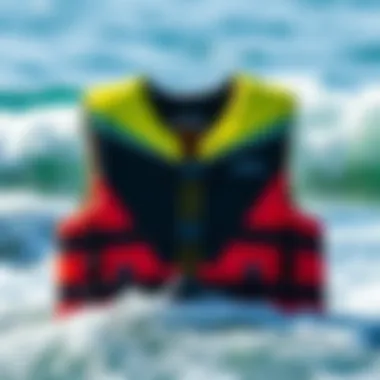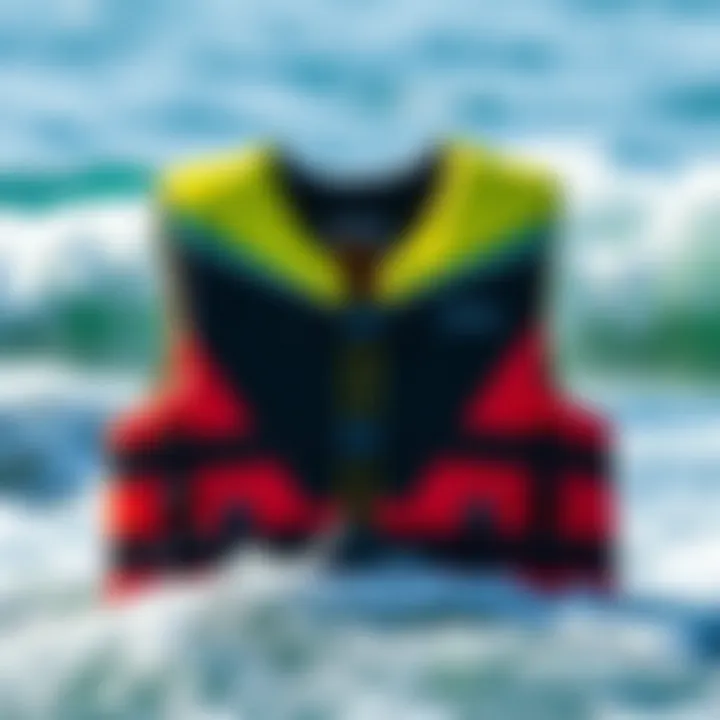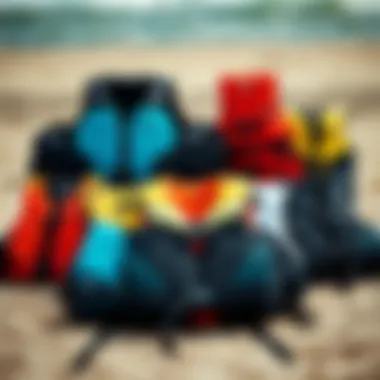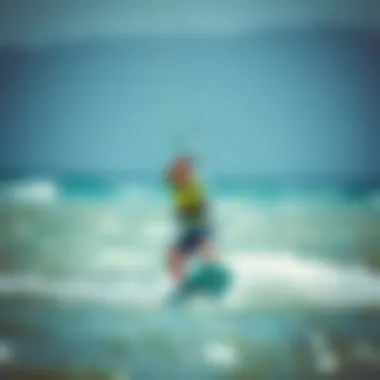The Role and Benefits of Surf Float Vests in Kiteboarding


Intro
Kiteboarding, a thrilling blend of surfing and paragliding, offers exhilarating experiences on water and in the wind. Yet, as every seasoned kiteboarder knows, safety is paramount. In this realm of winds and waves, surf float vests play an integral role, ensuring riders not only have fun but also stay safe amidst potential perils.
This article dives into the functionality and importance of these essential safety gears. Surf float vests, equipped with buoyancy-enhancing features, can be the difference between a casual jam and a harrowing situation. Furthermore, selecting the right vest involves understanding various options available and how they cater to different riding styles and conditions.
As we untangle the specifics of surf float vests, considerations will range from gear selection to maintenance and suitability for different user demographics, arming kiteboarders, instructors, and event organizers alike with valuable insights.
Gear Selection
Choosing the right kit for kiteboarding is akin to tailoring a garment to fit perfectly. It enhances the overall experience by marrying personal comfort with functional requirements. Let’s break this down further.
Types of Float Vests
When browsing for a float vest, it’s like searching for that perfect partner for your kite. There are various styles to consider:
- Buoyancy Float Vests: Designed primarily for buoyancy and safety. These are often thicker and offer more flotation.
- Lightweight Vests: Ideal for warmer water conditions, these provide comfort without compromising on safety.
- Multi-Sport Vests: Versatile options catering to both kiteboarding and other water sports like wakeboarding or surfing.
Each type serves a unique purpose, so assess your riding style and preferences.
Choosing the Right Board
Just as vital as the vest is the selection of your board. It’s not just about aesthetics or brand prestige, but a balance of compatibility with your skills and the conditions you’ll encounter:
- Freeride Boards: Known for versatility and ease of use, great for those honing their skills.
- Wave Boards: Shorter, designed for performance in dynamic wave conditions.
- Freestyle Boards: Tailored for tricks and jumps, suitable for those aiming for higher skill levels.
When matched correctly, a float vest and a board can elevate the experience, turning a good day into an unforgettable one.
Skill Development
To maximize the benefits of your gear, a kiteboarder must invest in skill development. Mastering essential techniques can enhance both safety and enjoyment.
Essential Techniques
Practicing proper body positioning, efficient kite control, and effective water starts can save you headaches down the line. Each element harmonizes with your float vest, ensuring it performs as intended.
- Body Positioning: Learning the right stance can prevent fatigue and improve stability.
- Kite Control: The ability to maneuver efficiently allows quicker responses to changing conditions.
- Water Starts: A key technique to gaining confidence, allowing smoother transitions into riding.
Progression Tips
Progressing from novice to seasoned kiteboarder doesn’t happen overnight. Here are some pointers to keep growth steady while remaining safe:
- Start with calm water conditions.
- Practice with experienced partners.
- Focus on techniques before trying advanced tricks.
- Learn to read wind patterns and water conditions to prepare for different scenarios.
Every kiteboarding journey is unique. Embrace the learning curve, and remember the float vest is there to make every ride safer.
Maintenance and Storage
A float vest is not a one-and-done investment. Like any piece of equipment, it requires attentive care:
- Rinsing After Use: Saltwater can degrade materials over time; a quick rinse makes a world of difference.
- Dry Storage: Ensure that it’s properly dried before packing away, preventing mildew and odors.
- Regular Inspections: Check for wear and tear regularly to ensure continued safety.
Understanding Surf Float Vests
Surf float vests are not just an accessory for kiteboarding; they fundamentaly influence both safety and performance on the water. Understanding these vests is akin to grasping the nuances of a life-saving device in an unpredictable environment. Kiteboarding involves harnessing wind power, and with that comes a fair share of risks. Those who navigate the waters know that having a reliable flotation device can mean the difference between a memorable adventure and a harrowing experience.
Definition and Purpose
At its core, a surf float vest serves as a buoyancy aid designed primarily for water sports enthusiasts. Its primary purpose is to provide flotation support should one find themselves in the water, but it's also built to enhance comfort and freedom of movement. When kiteboarding, a vest does more than keep a rider afloat; it contributes to their stability and confidence while tackling the waves and winds.
In essence, a surf float vest encapsulates several crucial elements. First, it offers buoyancy. This means that if a rider wipes out or loses control, the vest will help keep them afloat without needing to exert much effort. Second, it protects against impact. The material helps cushion falls, making it easier to bounce back, literally and figuratively. Lastly, many vests feature additional pockets for essentials, reinforcing their role as an all-in-one piece of gear.


Historical Overview of Safety Gear
The evolution of safety gear in water sports reflects a journey from rudimentary beginnings to sophisticated innovations. Back in the day, safety was often an afterthought for kiteboarders. In earlier times, life vests were bulky, heavy, and not suited for active movements, inhibiting performance rather than enhancing it. However, as kiteboarding grew in popularity, so did the demand for specialized safety gear.
In the late 1990s, manufacturers started redesigning flotation devices specifically for kiteboarding. The focus shifted towards lightweight materials and ergonomic designs, allowing riders to move freely while enjoying maximum safety. Today’s surf float vests are crafted from advanced materials that are both durable and lightweight, employing technologies arising from various sports and industries. This not only improves buoyancy but also extends the vest's lifespan in challenging conditions.
Moreover, organizations advocating for water safety have played an instrumental role in promoting better standards and practices in the use of float vests. This advocacy has pushed many riders to recognize the importance of incorporating such safety measures into their gear when they hit the water.
Overall, understanding the functionality and development of surf float vests equips kiteboarders with the context necessary to appreciate their vital role in the sport today.
Types of Surf Float Vests
When you paddle out into the exhilarating world of kiteboarding, having the right equipment is crucial. Among the equipment that stands out in terms of safety and utility are surf float vests. Understanding the different types of surf float vests can help you make informed choices that suit your specific riding style and conditions. In this section, we will dive into the distinct categories of surf float vests, namely buoyancy aids, impact vests, and hybrid models. Each type serves a unique purpose and carries its own benefits that are vital for both safety and performance on the water.
Buoyancy Aids
Buoyancy aids are designed primarily to keep you afloat in the water. They are lightweight and streamlined, which offers the freedom of movement while still providing essential buoyancy. This type of vest is particularly useful for beginners or those who may not be entirely confident in their swimming abilities. They can make a significant difference in maintaining buoyancy during those unexpected tumbles in the surf.
- Key Considerations: One important aspect of buoyancy aids is their fit. A snug, yet comfortable vest allows for optimal mobility without restricting your paddling and kite handling.
- Material: Look for vests made from durable materials that can withstand saltwater and sun exposure. Neoprene or other water-resistant fabrics are common choices that offer flexibility and some warmth, if needed.
Utilizing a buoyancy aid during your kiteboarding adventures can transform your time on the water, ensuring that you remain safe and secure, while also freeing you to focus on honing your skills on the board.
Impact Vests
Impact vests serve a different purpose but are no less important. These vests are built to absorb shock and protect your torso from potential injuries while riding at high speeds. In the event of a crash or a hard landing, impact vests may reduce the risk of injury, offering both comfort and confidence as you push your limits.
- Features: They often feature padding in key areas like the back and chest, which can be life-savers, especially for advanced riders attempting tricks. If you’re someone who thrives on adrenaline, this type of vest is worthy of your attention.
- Flexibility: While providing ample protection, impact vests also need to be flexible enough to allow for an athletic range of motion. A vest that compromises flexibility won't work in your favor when maneuvering through the water.
Investing in an impact vest is not just a precaution—it's a strategic decision that could make a world of difference on those days when you’re pushing the envelope of performance.
Hybrid Models
The hybrid models combine elements of buoyancy aids and impact vests, offering the best of both worlds. They are tailored to meet the needs of both safety and performance, catering to riders who demand a bit of both in their gear. If you're someone who values safety but isn't willing to sacrifice performance, hybrid models might be the solution.
- Versatility: These vests are designed for a wide range of conditions. Whether you are doing tricks or riding flat water, a hybrid vest adapts to the demands of the environment while ensuring you remain safe.
- Varied Designs: Different hybrid vests will offer varying features, so it's crucial to choose one that aligns with your specific needs. Check for options that have removable padding or adjustable buoyancy to customize your experience further.
Choosing a hybrid model can give you the peace of mind that you are fully equipped for the ride ahead, effectively merging safety and performance while keeping you buoyant and protected.
A well-chosen surf float vest is not just an accessory; it’s your lifeline in unpredictable waters, enhancing your kiteboarding experience.
In summary, understanding the differences among buoyancy aids, impact vests, and hybrid models is essential for kiteboarders at any level. Choosing the right vest not only enhances your safety but also boosts your overall performance, allowing you to ride with confidence and flair.
Choosing the Right Surf Float Vest
Selecting the appropriate surf float vest is central to enhancing both safety and performance while kiteboarding. With various styles and features available, the choice can feel daunting. However, understanding your individual needs and the specific advantages of each vest type makes this decision clearer. A well-chosen vest ensures not only comfort on the water but also confidence in its protective capabilities. This section explores important factors to consider, enabling kiteboarders to make informed choices that align with their riding style and safety requirements.
Assessing Your Needs
Before diving into the myriad options, reflect on your specific kiteboarding needs. Are you just starting out, or are you seasoned in the sport? Gold standard safety advice suggests newer riders may benefit more from buoyancy aids, while experienced ones might prefer impact vests that allow for freedom of movement without sacrificing protection.
- Skill Level: New users might prioritize flotation to build confidence aligning with their learning curve.
- Conditions: If you often find yourself in rough waters, level-headed protection becomes paramount. On the other hand, for calm sessions, comfort can take precedence.
- Riding Style: Freestyle kiteboarders may desire a more streamlined fit to permit high-skill tricks, while those interested in long-distance rides might value additional buoyancy.
"Understanding what you need isn’t just about fashion; it’s about enjoying the ride without worries."
Size and Fit Considerations
Getting the right size is critical, since a vest that’s too loose can be cumbersome, while one that’s too tight can restrict movement. It’s advisable to try different options, keeping in mind that sizing may differ between brands. Take into account:
- Chest Measurement: Measure the widest part of your chest to find the size that offers comfort and support.
- Try Before You Buy: When possible, put on the vest and mimic movements used in kiteboarding. It should feel like a second skin.
- Adjustable Features: Look for vests with adjustable straps that can conform to your body. These can provide a more personalized fit and enhance safety even further.
Materials and Construction Quality


The materials and build of a surf float vest can greatly affect not only its performance but also your overall experience on the water. Select vests crafted from high-quality materials, which tend to last longer and perform better.
- Neoprene: Commonly used for its flexibility and comfort. It usually provides good insulation but ensure it’s breathable too.
- Foam Composition: The buoyancy and impact resistance largely depend on the quality of foam. Closed-cell foam tends to offer better support and longevity.
- Durability Factors: Check for reinforced seams and sturdy zippers, as these components bear the brunt of wear over time.
In the journey of kiteboarding, the right surf float vest is not merely an accessory but a crucial element of safety and performance. By thoughtfully choosing the vest that complements your needs, fit, and the materials used, you're setting yourself up for success on the waves.
Benefits of Wearing a Surf Float Vest
In the dynamic and exhilarating world of kiteboarding, safety is paramount. Among the various piece of equipment used by enthusiasts, the surf float vest emerges as a critical component not just for safety, but for improving the overall experience. Here, we will delve into the key benefits of wearing a surf float vest, emphasizing enhanced safety, increased comfort, and improved performance.
Enhanced Safety
The foremost reason for equipping yourself with a surf float vest is undeniably for safety. Kiteboarding, while thrilling, can also be unpredictable. The water conditions, wind speeds, and sudden waves can turn a serene experience into a precarious one in the blink of an eye. A float vest not only helps in maintaining buoyancy but can also act as a shield against impacts.
When riders take a tumble, as is often the case, the float vest provides crucial flotation, allowing for quicker recovery and minimizing the risk of drowning. The design of many vests ensures that they stay snug against the body, preventing the vest from riding up, which can create a safety hazard. Moreover, in rough waters, the visibility features, like bright colors and reflective strips typical of these vests, enable nearby riders and safety teams to spot a user quickly, thus adding an extra layer of security.
"Safety should never be a secondary thought; it must be a primary action."
Increased Comfort
Beyond safeguarding, wearing a surf float vest contributes significantly to a rider's level of comfort. Anyone who has battled with uncomfortable gear will understand the importance of having a vest that fits well and feels comfortable. Many modern surf float vests are tailored with user comfort in mind, using lightweight materials that do not weigh the rider down. Breathable fabrics allow for adequate airflow, which is critical in warm weather when overheating can dampen the joy of kiteboarding.
Adjustable straps and ergonomic designs ensure a proper fit, allowing freedom of movement without sacrifice. An ill-fitting vest can be more of an impediment than a help, so selecting a vest that complements one’s body shape can make all the difference. Riders can focus on their technique and performance rather than adjusting equipment that doesn’t sit right.
Improved Performance
Lastly, let's talk about performance enhancement. A well-chosen float vest not only supports safety and comfort but also improves a rider's performance. The buoyancy provided by a float vest allows riders to have better control over their bodies when they are in the water, facilitating more precise maneuvers and techniques. This buoyancy can also help decrease fatigue during prolonged sessions since riders will expend less energy fighting against the water.
Moreover, many surf float vests are designed to be sleek and streamlined. This minimizes drag as a rider moves through waves and chop, allowing for faster speeds and better handling. The psychological benefits of wearing a float vest cannot be ignored either; when riders feel safe and comfortable, they're likely to push their limits and ride confidently.
In summary, the benefits of wearing a surf float vest during kiteboarding extend beyond just protecting the individual. They encompass safety enhancements, greater comfort, and an overall boost in performance, making them indispensable for enthusiasts of all levels.
Maintenance of Surf Float Vests
Taking care of surf float vests is as essential as choosing the right one. Without proper maintenance, even the most reliable float vest could let you down when it counts the most. Just like a well-tuned kite, a clean and well-kept vest ensures safety, comfort, and performance while you're out there riding the waves.
Cleaning Procedures
Cleanliness is vital for both function and longevity of surf float vests. Exposed to saltwater, sand, and the sun, these vests accumulate dirt and may start to lose their buoyancy over time if neglected. Here are some steps to follow:
- Rinse After Every Use: Right after you pack up your kite and land onshore, rinse your vest in freshwater. This washes away salt and debris that can cause deterioration.
- Gentle Cleaning Agents: Occasionally, use mild soap to clean spots. This helps get rid of stubborn marks without damaging the fabric. Steer clear of harsh detergents, as they may weaken the material.
- Air Dry Properly: Never toss your vest in the dryer. Instead, hang it up in a shaded area to dry. Sunlight can affect the vest's material adversely, so keeping it out of direct light is wise.
- Inspect Regularly: Look for any signs of wear and tear, including frayed straps or damaged buckles. Catching issues early can prevent mishaps later on.
Regular maintenance not only prolongs the life of the float vest but also enhances safety while kiteboarding.
By incorporating these basic cleaning steps into your post-kite routine, you will ensure that your surf float vest remains functional and reliable.
Storage Recommendations
How you store your surf float vest when it's not in use is equally important. Proper storage prevents problems caused by neglect and environmental factors.
- Dry and Cool Place: Always store your vest in a dry place with a consistent temperature. Moisture and heat can lead to mold growth or weakening of materials over time.
- Avoid Folding: Instead of folding your vest, try rolling it. Folding can create creases that might compromise the fabric’s integrity. When rolled, the vest maintains its shape better.
- Use a Bag: If possible, keep your vest in a breathable bag. This provides an additional layer of protection from dust and allows moisture to escape.
- Shield from Pests: Be mindful of pesky critters, like rodents. Ensure your storage area is free from nests or nesting materials that might invite unwelcome guests.
Environmental Impact and Sustainability
The use of surf float vests in kiteboarding not only addresses safety and performance, but it also raises crucial questions about environmental responsibility. As awareness of environmental issues grows, more enthusiasts are considering how their choices affect the planet. Given the amount of plastic and other materials involved in manufacturing these vests, it's essential to address both sustainability in materials and disposal practices.
Material Sustainability
When choosing a surf float vest, selecting sustainable materials is becoming increasingly vital. Many vests are crafted from neoprene, a synthetic rubber that offers durability and flexibility, yet is not renowned for its eco-friendliness. However, some manufacturers have begun using eco-conscious alternatives. For instance, vests made from natural rubber or recycled materials help reduce the reliance on petroleum-based products.
Moreover, opting for companies that focus on sustainable production methods can make a significant difference. These brands often prioritize:


- Renewable resources: Using natural fibers or biodegradable components.
- Low-impact manufacturing: Reducing waste and emissions during production.
- Transparency: Providing information on their supply chain and practices.
As the kiteboarding community shifts towards a more sustainable future, it’s prudent for riders to seek out brands committed to minimizing their environmental footprint. Choosing vests made from recycled or eco-friendly materials not only contributes to personal safety but also reflects a concern for the ocean and environment that kiteboarders share collectively.
Responsible Disposal Options
Disposing of surf float vests properly is often overlooked. Many traditional vests end up in landfills, contributing to pollution that affects marine life. Understanding the best practices for disposing of or recycling old vests is fundamental in promoting sustainability. Here are several options:
- Recycling Programs: Some companies offer take-back programs for used vests, allowing them to be recycled or repurposed. Brands like Patagonia have already started such initiatives.
- Donation: If the vest is still usable, consider donating it to schools or organizations that introduce youth to water sports. This helps keep gear in circulation while promoting safety in the sport.
- Upcycling: Creative enthusiasts might transform old vests into useful items, like bags or accessories. Engaging in such projects not only gives a second life to the material but also raises awareness about waste reduction.
"It's not just about the ride; it's about how we care for the waters that host our adventures."
Surf Float Vests for Different Demographics
Understanding the significance of surf float vests covers more than just safety or performance; it extends to the diverse user groups that rely on these essential pieces of gear. Each demographic, varying from beginners to experienced riders, has distinct requirements and considerations that must be addressed to optimize their kiteboarding experience. It is vital to recognize how these variations inform the design, functionality, and selection of surf float vests.
Beginners and Novices
When it comes to novice kiteboarders, the primary focus tends to be on safety and confidence building. For these individuals, a surf float vest serves as a reassuring lifeline, allowing them to learn the ropes without the looming fear of potential hazards. The design should prioritize buoyancy and comfort.
A vest that fits snugly but does not restrict movement is ideal. A few features to consider include:
- Buoyant Front Panels: Helps provide ample flotation for someone still learning how to manage the board and the kite.
- Lightweight Fabric: Ensures that even when slightly submerged, the vest doesn’t drag the wearer down.
- Ease of Donning: Vests that are easy to put on and take off can help novices quickly adapt to changing conditions.
For beginners, opting for a vest that is specifically tailored for learning can prevent accidents and enhance the overall experience on the water.
Children's Safety Gear
Children represent a unique demographic within the kiteboarding sphere. Their size, weight, and level of maturity greatly shape the type of surf float vest they require. It’s not merely about a smaller version of an adult's vest; it needs to be specifically designed for safety and fun.
Several key aspects come into play:
- Kid-Friendly Design: Bright colors and playful styles can make children feel more excited about wearing their vests.
- Superb Floatation: Focus on maximum buoyancy to ensure that if a child falls, the vest helps keep them afloat and visible.
- Secure Fit Systems: Adjustable straps and closures help keep the vest snug but comfortable, accommodating for growth.
Ultimately, ensuring the gear fits well can instill not just safety but also confidence in young riders as they navigate the waves.
Advanced Riders' Requirements
While beginners focus on buoyancy and comfort, advanced kiteboarders value performance and specific features that allow for greater agility. For these riders, a surf float vest is about finding the balance between safety and minimal drag.
Advanced riders often look for:
- Impact Resistance: Vests designed with robust materials can protect against falls and collisions without sacrificing freedom of movement.
- Streamlined Profiles: A slim-fitting design minimizes drag, allowing for faster speeds and more agility when executing tricks.
- Strategic Padding: Smart padding choices can offer both protection and comfort without compromising flexibility.
Understanding these nuanced requirements for advanced kiteboarders can influence how manufacturers design vests to meet their needs, ensuring a safer and more enjoyable experience.
By catering to the specific needs of each demographic, surf float vests provide tailored solutions that enhance safety, comfort, and performance across the board. Recognizing these differences is essential for anyone involved in kiteboarding, from instructors to event organizers, to foster a culture of safety and enjoyment on the water.
Finale
Navigating the waters of kiteboarding without proper safety gear can be a precarious endeavor. The surf float vest emerges as a cornerstone of safety, ensuring that riders are equipped to handle various conditions on the water. Understanding its importance is not just beneficial; it’s essential.
Summary of Key Points
Throughout this article, key elements have highlighted the significance of surf float vests. These include:
- Enhanced Safety: Vests provide buoyancy, helping riders to stay afloat during unexpected falls.
- Diverse Types: From buoyancy aids to impact vests, the variety in design caters to different riding styles and skill levels.
- Long-Term Maintenance: Proper care extends the life of the vest, ensuring reliability whenever it’s needed.
- User Demographics: Understanding the specific needs of diverse groups—like beginners, children, and advanced riders—enables tailored choices for improved safety.
This summary encapsulates the multi-faceted role surf float vests play, underlining that informed choices lead to enhanced safety and enjoyment in kiteboarding.
Final Thoughts on Safety in Kiteboarding
The water can be a fickle friend, and kiteboarding certainly has its share of unpredictability. Investing time to choose the right surf float vest isn’t merely a precaution; it’s a proactive measure that can drastically lessen the risks involved.
"Choosing the right gear is half the journey to mastering the waves."
For kiteboarders of all levels, understanding the function and importance of surf float vests allows them to ride with confidence. New or inexperienced riders should prioritize safety gear as a fundamental element of their kiteboarding experience, while seasoned veterans can benefit from revisiting their gear choices.
Ultimately, staying safe on the water is about respect—respect for the sport, fellow riders, and oneself. Ensuring you're equipped properly allows for a more enjoyable, less stressful, and ultimately safer experience on the waves. By doing so, you’re not just enjoying the thrill of kiteboarding; you’re embodying the spirit of the sport responsibly.















